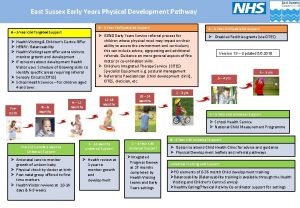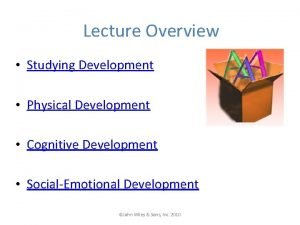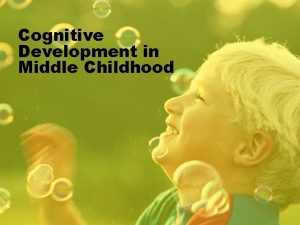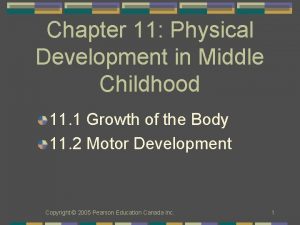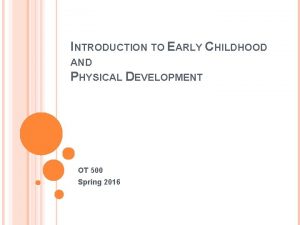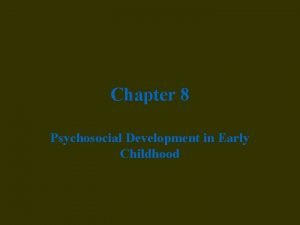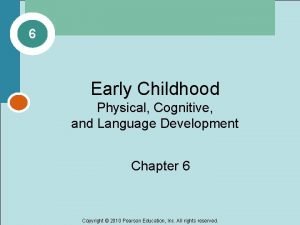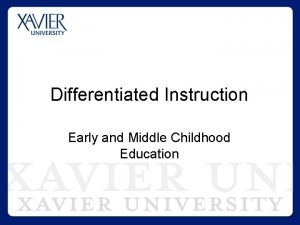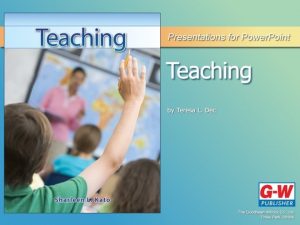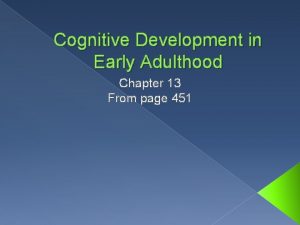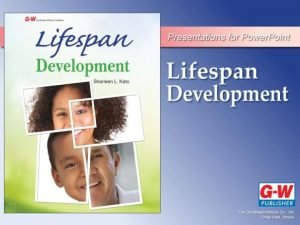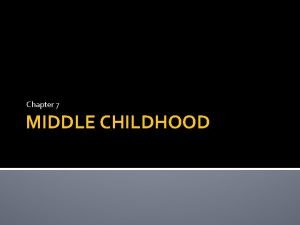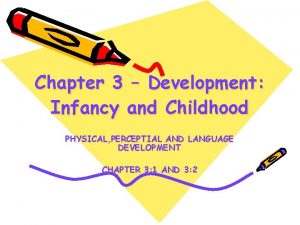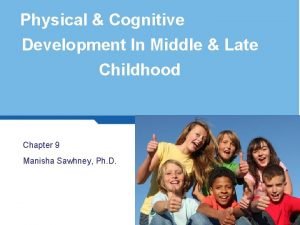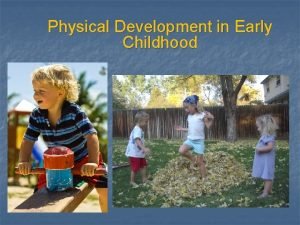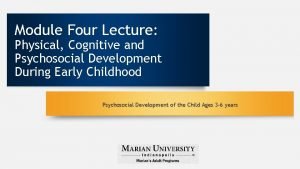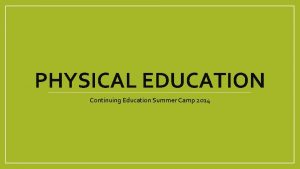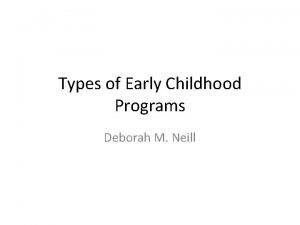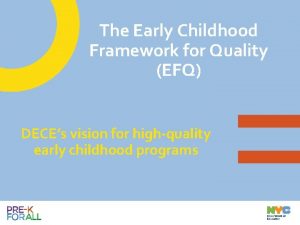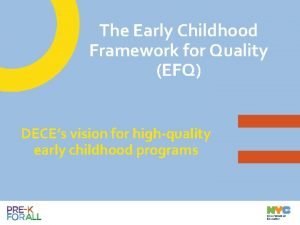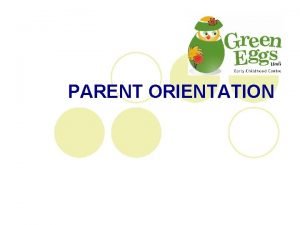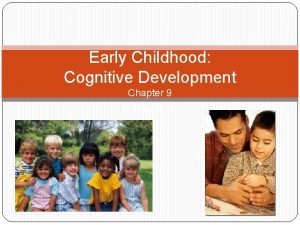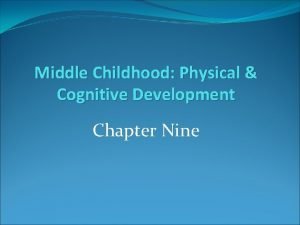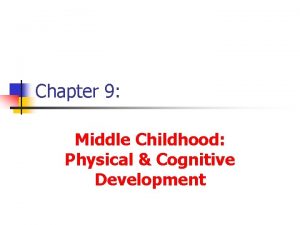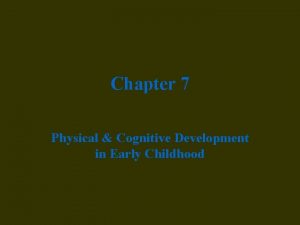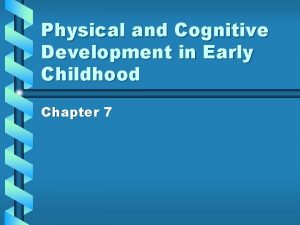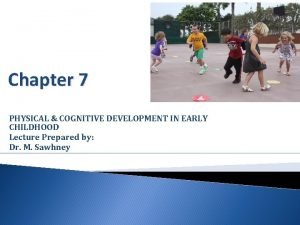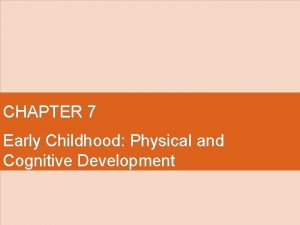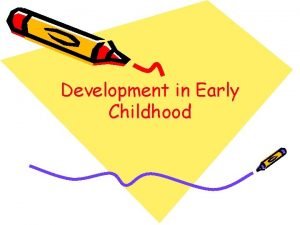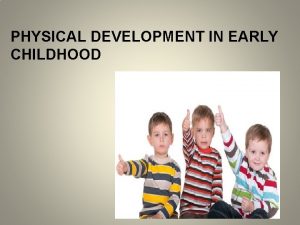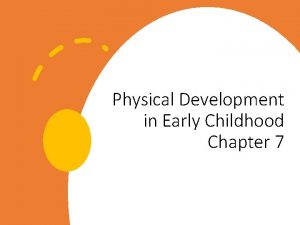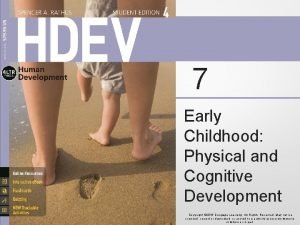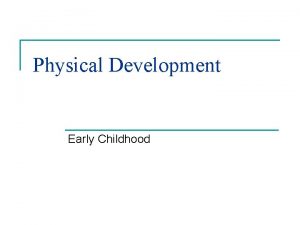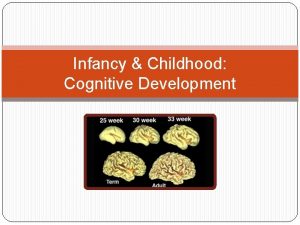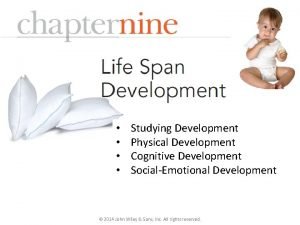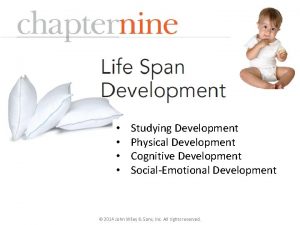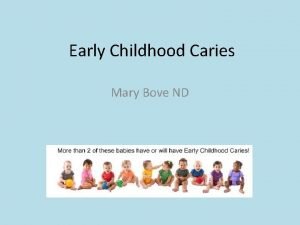Chapter 7 Early Childhood Physical Cognitive Development Growth




































- Slides: 36

Chapter 7: Early Childhood: Physical & Cognitive Development

Growth Patterns: n n n Growth rate slows during the preschool years. Height: 2 -3 inches/yr Weight: 4 -6 lbs. /yr Children become more slender as they get taller and lose baby fat. Boys generally become slightly taller and heavier than girls.

Brain Development: n n n By 2: 75% of adult weight By 5: 90% of adult weight This growth due to continued myelinization. Myelinization of the corpus collosum allows integration of logical and emotional functioning Brain shows plascticity

What is Brain Plasticity? n n n The brain’s ability to compensate for injuries to particular parts of the brain Plasticity greatest at 1 to 2 years of age; preschoolers with damage to language areas can overcome them due to plasticity Sprouting (growth of new dendrites) may contribute to brain’s plasticity; redundancy of neural connections may also contribute

Brain Plasticity (a real example!)

Gross Motor Development: n n n Movement which involves the large muscles used in locomotion. As nervous system matures, movements become more precise and coordinated. Boys and girls are similar in motor skills: Girls slight advantage in: balance and precision Boys slight advantage in: throwing and kicking


Gross Motor Development, Cont. n n Rough and tumble play: Running, chasing, hitting w/open hand, laughing, making faces. Helps develop physical and social skills.

Q: Is rough and tumble play the same as aggression? No! n What is aggressive behavior? Hitting, pushing, taking, grabbing, angry looks. (Rough and tumble play helps develop physical and social skills in children; aggression does not)

Physical Activity: n n n Preschoolers spend an average of 25 hours a week in large muscle activity; decreases as child ages The more physically active the parent, the more physically active the child Twin studies suggest heredity component of activity

Fine Motor Development: n Fine motor skills include control of wrists and fingers; develop slowly and lag behind gross motor skills; consist of buttoning, tying shoelaces, stacking blocks


Handedness: n n n Handedness emerges during infancy; by 7 to 11 months preference for particular hand increases; by age 4 clear preference for handedness. Left-handedness associated with dyslexia, stuttering, high blood pressure, epilepsy, schizophrenia and depression; ALSO associated with higher math ability, success in athletics, success in musical fields, architectural fields and the arts Heredity contributes to handedness

Nutrition n n 4 to 6 year olds need 1, 400 calories a day; 1 to 3 year olds need 1, 000 to 1, 300 Appetite becomes erratic during 2 nd and 3 rd year of life Children are often fed too much salt and sugar Food preferences are somewhat environmental Repeated exposure to a food increases the liking of it; parents are the role model for which types of food a child will like to eat

Preoperational Stage n n Lasts from age 2 to age 7 Characterized by the use of symbols to represent objects and relationships among them. Language ability greatest symbolic activity during this stage; scribbling/drawing begins at start of this stage Symbolism is also expressed as symbolic or pretend play.

The Preoperational Stage is Characterized by: n n n 1. 2. 3. 4. 5. Symbolic play Egocentrism Precausal thinking Conservation Appearance as reality.

1. Symbolic “Pretend” Play n n n Engaged in from 15 months of age; increases in complexity as child ages Requires cognitive sophistication because it requires child to use and recollect symbols (things he has learned about or experienced) First engage in pretend play at: 12 -13 mo: Perform familiar activities (feed self) 15 -20 mo: Feed a doll (shift focus from self to others) 30 mo: Doll is feeding self Older preschooler: comb doll hair, have a teaparty, help doll drink it, etc.

2. Egocentrism: n n n Children do not understand that others do not see the world as they do. One dimensional thinking Measured by the three mountains test.

3. Precausal Thinking: Reasoning about events that is egocentric and not based on science. Exhibited 3 ways: 1. Transductive reasoning: reasoning by going from one specific isolated event to another 2. Animism: attribution of life and intentions to inanimate objects 3. Artificialism: assumes environmental factors such as rain and thunder have been designed and made by people n

4. Conservation: n n n Preoperational age children can only focus on one dimension at a time, called Centration. Conservation — law that holds that properties of substances such as volume, mass and number remain the same even if you change their shape or arrangement The preoperational child has not mastered “reversibility”



5. Appearance as Reality: n n Appearance-reality distinction — understanding the difference between real events and mental events A belief that an objects appearance tells you what the object is really like.

Class Inclusion: n Including new objects or categories in broader mental classes or categories; requires child to focus on two aspects of a situation at once; this skill not observed during preoperational stage

Class Inclusion Example: Q: Are there more dogs, or animals?

What are the 3 Factors That Influence a Child’s Cognitive Development? n n Scaffolding — temporary support provided by a parent or teacher to learning children; guidance by adult decreases as child is capable of carrying out task on their own. Zone of proximal development (ZPD) — the gap between what children are capable of doing alone and what they could do with help from others; adults or older children help in guiding by gearing assistance to children’s capabilities

What are the 3 Factors That Influence a Child’s Cognitive Development? , cont. n n Inner Speech: At first children’s thoughts are spoken out loud, which serves to regulate her behavior. Gradually the thoughts become internalized, which is the ultimate binding of language and thought.

Effects of Early Childhood Education: n n n Preschool education enables children to get an early start on achievement in school Higher the SES, the greater the performance of standardized intelligence tests, because of this, preschool programs such as Head Start began in 1960’s Environmental enrichment as well as parent education can enhance cognitive development of economically disadvantaged

Development of Memory: n n n By age 4 children can remember events from 1 1/2 years earlier Young children form scripts when describing what happens during a particular event; the script becomes more elaborate as it is told Autobiographical memory (episodic memory) — memory for specific events is facilitated by children talking about them with others.

What are the Factors That Influence Memory? n n n Order: Children remember events that follow a logical order more easily Interest: Children remember according to what interested them Cues from others: Younger children depend on older children or parent for cues to help them retrieve their memories

Know! n Parental interest and questioning increases preschooler’s memory.

Language Development: n n n Preschoolers learn an average of 9 new words a day. Word learning does not occur gradually. Fast-mapping — process where child quickly attaches a new word to its appropriate concept

Development of Grammar: Children’s sentence structure increases during 3 rd year of life, due to a grammar explosion. Including: n Articles (a, an, the) n Conjunctions (and, but, or) n Possessive adjectives (your, her) n Pronouns (she, him, one) n Prepositions (in, over, around, under, through) n

Grammar, cont. Overregularization — children acquire grammatical rules as they learn language; young ages apply rules rigidly even in cases where there are exceptions. Ex: “Mommy sitted down” “The sheeps I seed at the farm” “The childs I saw at the park” n

Asking Questions: n n n First question tend to be telegraphic and characterized by a rising pitch. After 3 certain Wh questions (what, who, where) appear earlier than others (why, when, which, how) Later the child will add the verbs is, did, and will to indicate whether the question concerns the present, past or future.

Pragmatics: Practical application of language; children demonstrate pragmatics when they adjust speech to fit the social situation “Social language” n
 Early childhood is __________ for language learning
Early childhood is __________ for language learning Physical development in early childhood
Physical development in early childhood 3 stages of prenatal development
3 stages of prenatal development Physical and cognitive development in early adulthood
Physical and cognitive development in early adulthood Cognitive development in adulthood
Cognitive development in adulthood Infancy early childhood middle childhood adolescence
Infancy early childhood middle childhood adolescence Middle and late childhood
Middle and late childhood Module 47 infancy and childhood cognitive development
Module 47 infancy and childhood cognitive development Cognitive development in middle childhood
Cognitive development in middle childhood Module 47 infancy and childhood cognitive development
Module 47 infancy and childhood cognitive development Physical development in middle childhood chapter 11
Physical development in middle childhood chapter 11 Fine motor skills development in early childhood
Fine motor skills development in early childhood Psychosocial development in early childhood
Psychosocial development in early childhood Language development in early childhood
Language development in early childhood Biosocial development in early childhood
Biosocial development in early childhood Early childhood development with differentiated instruction
Early childhood development with differentiated instruction Middle childhood growth and development
Middle childhood growth and development Cognitive development in early adulthood
Cognitive development in early adulthood Chapter 2 types of early childhood programs
Chapter 2 types of early childhood programs Chapter 7 early childhood ages 3 through 5
Chapter 7 early childhood ages 3 through 5 Physical development in middle childhood
Physical development in middle childhood Internally programmed growth of a child
Internally programmed growth of a child Late childhood
Late childhood Physical development in middle childhood
Physical development in middle childhood Module 46 infancy and childhood physical development
Module 46 infancy and childhood physical development Define physical cognitive and psychosocial development
Define physical cognitive and psychosocial development Psychosocial development in early adulthood
Psychosocial development in early adulthood Summer camp 2014
Summer camp 2014 Cognitive and non cognitive religious language
Cognitive and non cognitive religious language Chapter 5 cognitive development in infancy and toddlerhood
Chapter 5 cognitive development in infancy and toddlerhood Three types of early childhood programs
Three types of early childhood programs Efq framework
Efq framework Early childhood framework for quality
Early childhood framework for quality Ecetp trainings
Ecetp trainings Green eggs early childhood centre
Green eggs early childhood centre Early childhood directorate nsw
Early childhood directorate nsw Leonard di vinci
Leonard di vinci

